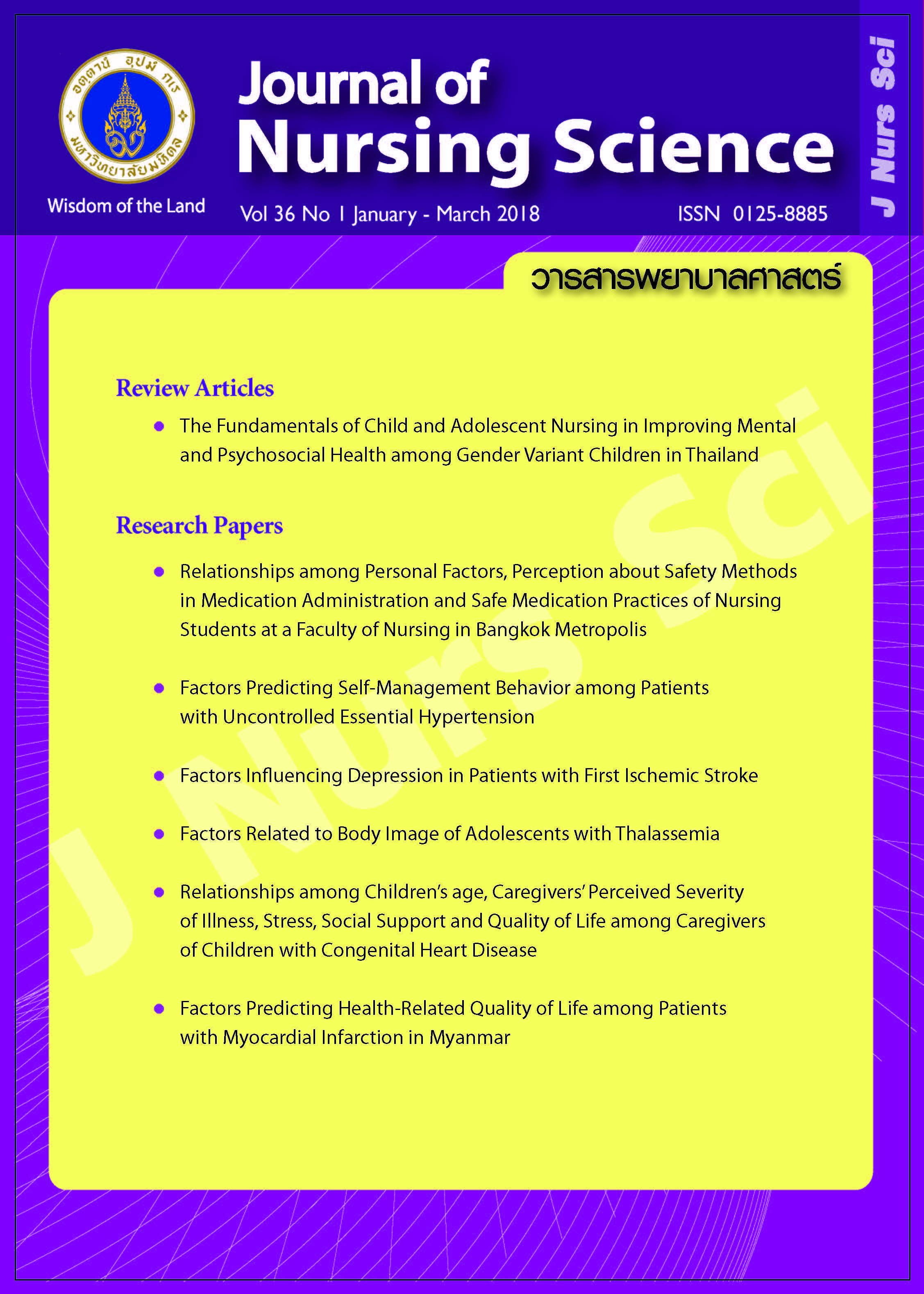Relationships among Personal Factors, Perception about Safety Methods in Medication Administration and Safe Medication Practices of Nursing Students at a Faculty of Nursing in Bangkok Metropolis
Main Article Content
Abstract
Purposes: To study the relationships among personal factors, perception about safety methods in medication administration and safe medication practices of nursing students.
Design: Descriptive correlational study.
Methods: A sample of 420 nursing students who had medication administration experience at least 5 times was recruited from a Faculty of Nursing in Bangkok Metropolis. Data were collected using three questionnaires: Personal Information Form, Safe Medication Practices, and Perception about Safety Methods in Medication Administration, respectively. Data were analyzed using descriptive statistics and Pearson product moment correlation.
Main findings: Mean age of 420 nursing students was 21.62 years old (SD = 1.15). The results showed that 97.4 % of nursing students perceived the importance of safety methods in medication administration at a high and very high levels; and 73.6% of them practiced in safe medication administration at a very low risk level. Perception about safety methods in medication administration (r = .464), self-preparation (r = .358), awareness of patient safety (r = .302), self-training (r = .238), perception of self-importance (r = .181), and age (r = .153) were positively related to safe medication practices at a statistical significance level .05.
Conclusion and recommendations: Perception about safety methods in medication
administration, self-preparation, awareness of patient safety, self-training and perception of
self-importance are important factors for safe medication practices of nursing students. Nurse
instructors should monitor students’ perceptions about safety methods in medication
administration, encourage them to perform self-preparation for knowledge and self-training for
increasing their knowledge, experiences, and skills in safe medication practices. Moreover, they
need to stress on students’ awareness about patient safety and also how important the nursing
students are in the process of safety medication administration to improve the safe medication
practices and minimize the risk of medication error.
Article Details
Copyright Notice: Nursing Science Journal of Thailand has exclusive rights to publish and distribute the manuscript and all contents therein. Without the journal’s permission, the dissemination of the manuscript in another journal or online, and the reproduction of the manuscript for non-educational purpose are prohibited.

Disclaimer: The opinion expressed and figures provided in this journal, NSJT, are the sole responsibility of the authors. The editorial board bears no responsibility in this regard.
References
mediacentre/news/releases/2017/medication-related-errors.
2. Hicks RW, Becker SC, Windle PE, Krenzischek DA. Medication errors in the PACU. J Perianesth Nurs. 2007;22(6):413-9.
3. National Patient Safety Agency. Safety in doses: improving the use of medicines in the NHS (published 2009) [Internet]. London: National Reporting and Learning Service (NRLS); 2009 [cited 2017 Mar 31]. Available from: http://www.nrls.npsa.nhs.uk/resources/?entryid45=61625.
4. Morimoto T, Sakuma M, Matsui K, Kuramoto N, Toshiro J, Murakami J, et al. Incidence of adverse drug events and medication errors in Japan: the JADE study. J Gen Inter Med. 2011;26(2):148-53.
5. Lanzillotti Lda S, de Seta MH, de Andrade CL, Mendes Junior WV. Adverse events and other incidents in neonatal intensive care units. Cien Saude Colet. 2015;20(3):937-46.
6. Seys D, Wu AW, Van Gerven E, Vleugels A, Euwema M, Panella M, et al. Health care professionals as second victims after adverse events: a systematic review. Eval Health Prof. 2013;36(2):135-62.
7. Cousins DH, Gerrett D, Warner B. A review of medication incidents reported to the National Reporting and Learning System in England and Wales over 6 years (2005-2010). Br J Clin Pharmacol. 2012;74(4):597-604.
8. Alsulami Z, Conroy S, Choonara I. Medication errors in the Middle East countries: a systematic review of the literature. Euro J Clin Pharmacol. 2013;69(4):995-1008.
9. Mansouri A, Ahmadvand A, Hadjibabaie M, Kargar M, Javadi M, Gholami K. Types and severity of medication errors in Iran: a review of the current literature. Daru. 2013;21(1):49.
10. Wolf ZB, Hicks RJF, Serembus JF. Characteristics of madication errors made by students during the administration phase: a descriptive study. J Prof Nurs. 2006;22(1):39-51.
11. National Coordinating Council for Medication Error Reporting and Prevention. What is a medication error? [Internet]. Rockville, MD: NCCMERP; 2001 [cited 2014 Dec 21]. Available from: http://www.
nccmerp.org/about-medication-errors.
12. Institute for Safe Medication Practices (ISMP). Error-prone conditions that lead to student nurse-related errors [Internet]. Horsham, PA: ISMP; 2007 [cited 2014 Dec 22] Available from: http://www.ismp’org/newsletters/acutecare/articles/20071018.asp.
13. Valdez LP, de Guzman A, Escolar-Chua R. A structural equation modeling of the factors affecting student nurses’ medication errors. Nurse Educ Today. 2013;33(3):222-8.
14. Ningsanon T. Medication administration for patient safety. 3rd ed. Bangkok: Hospital Pharmacy Association; 2011. (in Thai).
15. Elliott M, Liu Y. The nine rights of medication administration: an overview. Br J Nurs. 2010;19(5):300-5.
16. Apinan. Theory of perception [Internet]. 2012 [cited 2014 Dec 1]. Available from: http://finearts.exteen.com/20121109/entry. (in Thai).
17. Mayo AM, Duncan D. Nurse perceptions of medication errors: what we need to know for patient safety. J Nurs Care Qual. 2004;19(3):209-17.
18. Sulosaari V, Kajander S, Hup IM, Huupponen R, Leino-Kilpi H. Nurses students’ medication competence--an integrative review of the associated factors. Nurse Educ Today. 2012;32(4):399-405.
19. Aggar C, Dawson S. Evaluation of student nurses’ perception of preparedness for oral medication administration in clinical practice: a collaborative study. Nurse Educ Today. 2014;34(6):899-903.
20. Vaismoradi M, Jordan S, Turunen H, Bondas T. Nursing students’ perspectives of cause of medication errors. Nurse Educ Today. 2014;34(3):434-40.
21. Valdez LP, de Guzman Aduc, Escolar-Chua RA. Structural equation modeling of the factors
affecting student nurses’ medication errors. Nurse Educ Today. 2013;33(3):222-8.
22. Krauscheid LC, Orton VJ, Chorpenning L, Ryerson R. Student nurse perceptions of effective medication administration education. International Journal of Nursing Education Scholarship. 2011;8(1). doi: 10.2202/1548-923X.2178.
23. National Statistical Service. Sample size calculator [Internet]. Belconnen, Australia: National Statistical Service; 2008. Available from: http://www.nss.gov.au/nss/home.nsf/pagesSample+size+calculator.
24. Wright K. An exploration into the most effective way to teach drug calculation skills to nursing students. Nurse Educ Today. 2005;25(6):430-36.
25. Page K, McKinney AA. Addressing medication errors – The role of undergraduate nurse education.
Nurse Educ Today. 2007;27(3):219-24.


